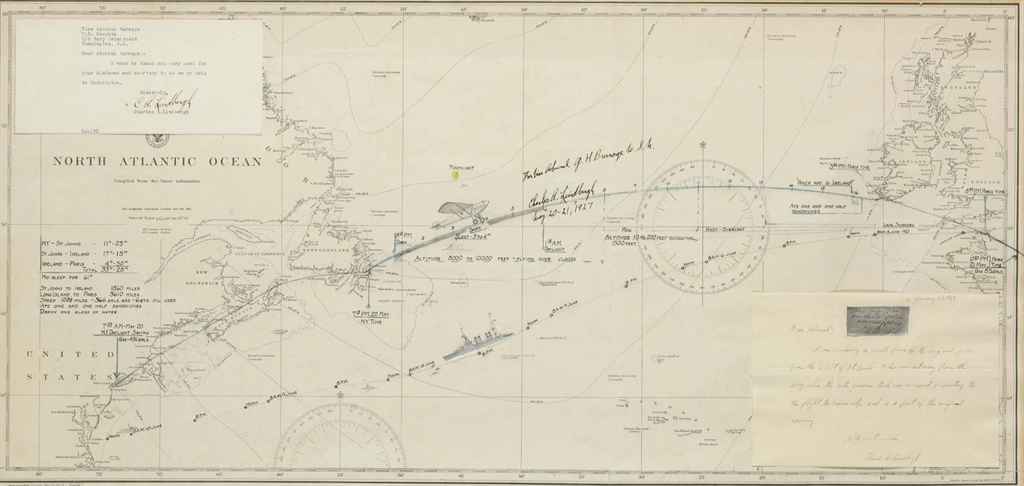LINDBERGH, Charles A. Printed Map of North Atlantic Lane Routes, signed ("Lindbergh"), initialed ("C.A.L.") and inscribed, ("Chart used in laying out New York to Paris route. San Diego, 1927"). Washington, D.C., U.S. Navy Hydrographic Department, March 1925. 49 x 30 in., with Navy Department stamp 15 January 1927 . PLANNING THE FIRST SOLO FLIGHT ACROSS THE ATLANTIC: A NORTH ATLANTIC SHIP ROUTES MAP USED BY LINDBERGH A crucial, exciting artifact of one of the pivotal technical achievements of the 20th century, Charles Lindbergh's solo flight from New York to Paris in May 1927. Lindbergh's many admirers liked to stress the minimalist quality of his flight, how he got his plane to Paris with nothing more technically advanced than a compass, his airspeed indicator, determination and luck. Lindbergh himself later claimed that as of the time of his trip to San Diego in late February 1927, he had still not even calculated the exact mileage between New York and Paris, and that he and Donald Hall went forthwith to the Public Library and crudely measured it out with a piece of string. Even so, he started seriously boning up after his arrival in San Diego. He meticulously prepared for his crossing, calculating his fuel and weighing his cargo to the last ounce. Parachutes and night-flying gear were scrapped to free up more fuel. Later he even opted to forego a radio and sextant to give himself 25 more pounds of gas. When it came time to begin serious navigational preparations, Lindbergh thought of consulting Naval officers stationed in San Diego, but claims he was too embarrassed to approach them. There was "enough skepticism about my flight...without adding to it by showing how inexperienced I am in the technique of long-distance navigation" (Berg, Lindbergh , 101). On 7 March he flew down to Los Angeles and "In the harbor area of San Pedro he found a store that sold every chart he could imagine necessary for his Atlantic crossing--Mercator's projections, a gnomonic projection, a time-zone chart of the world, a chart of magnetic variation, even a few maps showing prevailing winds over the Atlantic during the spring months" (Berg, 101). This map of sea lane routes would give him crucial visual points of reference, as well as familiarizing him with potential rescue ships if--worse case scenario-- he had to ditch in the Atlantic.
LINDBERGH, Charles A. Printed Map of North Atlantic Lane Routes, signed ("Lindbergh"), initialed ("C.A.L.") and inscribed, ("Chart used in laying out New York to Paris route. San Diego, 1927"). Washington, D.C., U.S. Navy Hydrographic Department, March 1925. 49 x 30 in., with Navy Department stamp 15 January 1927 . PLANNING THE FIRST SOLO FLIGHT ACROSS THE ATLANTIC: A NORTH ATLANTIC SHIP ROUTES MAP USED BY LINDBERGH A crucial, exciting artifact of one of the pivotal technical achievements of the 20th century, Charles Lindbergh's solo flight from New York to Paris in May 1927. Lindbergh's many admirers liked to stress the minimalist quality of his flight, how he got his plane to Paris with nothing more technically advanced than a compass, his airspeed indicator, determination and luck. Lindbergh himself later claimed that as of the time of his trip to San Diego in late February 1927, he had still not even calculated the exact mileage between New York and Paris, and that he and Donald Hall went forthwith to the Public Library and crudely measured it out with a piece of string. Even so, he started seriously boning up after his arrival in San Diego. He meticulously prepared for his crossing, calculating his fuel and weighing his cargo to the last ounce. Parachutes and night-flying gear were scrapped to free up more fuel. Later he even opted to forego a radio and sextant to give himself 25 more pounds of gas. When it came time to begin serious navigational preparations, Lindbergh thought of consulting Naval officers stationed in San Diego, but claims he was too embarrassed to approach them. There was "enough skepticism about my flight...without adding to it by showing how inexperienced I am in the technique of long-distance navigation" (Berg, Lindbergh , 101). On 7 March he flew down to Los Angeles and "In the harbor area of San Pedro he found a store that sold every chart he could imagine necessary for his Atlantic crossing--Mercator's projections, a gnomonic projection, a time-zone chart of the world, a chart of magnetic variation, even a few maps showing prevailing winds over the Atlantic during the spring months" (Berg, 101). This map of sea lane routes would give him crucial visual points of reference, as well as familiarizing him with potential rescue ships if--worse case scenario-- he had to ditch in the Atlantic.















Testen Sie LotSearch und seine Premium-Features 7 Tage - ohne Kosten!
Lassen Sie sich automatisch über neue Objekte in kommenden Auktionen benachrichtigen.
Suchauftrag anlegen